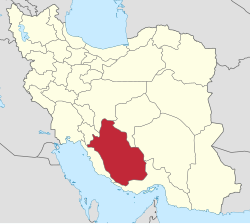 Izadkhast Caravanserai in August 2018 | |
| Location | Izadkhvast, Abadeh County, Iran |
|---|---|
| Region | Fars province |
| Coordinates | 31°30′58″N52°07′26″E / 31.51611°N 52.12389°E |
| Type | Caravanserai |
| Part of | The Complex of Izadkhast |
| Site notes | |
| Condition | Ruined |
| Public access | Yes |
| Architecture | |
| Architectural styles | Sasanian, Qajar |
| Part of | The Persian Caravanserai |
| Criteria | Cultural: ii, iii |
| Reference | 1668-031 |
| Inscription | 2023 (45th Session) |
The Izadkhast Caravanserai (lit: "God Desire") is a historic site located in Izadkhast, Fars province, Iran. It was a caravanserai or roadside inn on the ancient Silk Road, serving caravaners and travelers as a place for rest and recovery during long journeys. It is situated in the historical complex of Izadkhast, lying in a natural low basin looking onto the Izadkhast Castle situated in the nearby high bedrock. [1] Its construction dates to the early 17th century during the reign of Abbas the Great. [2]
Contents
Izadkhast Caravanserai is one of just 25 caravanserais on the UNESCO List of Persian Caravanserai from among hundreds of other caravanserais from all over Iran. [3] The complex of Izadkhast with the Izadkhast Caravanserai and Izadkhast Castle has been on the UNESCO Tentative List for World Heritage status since 2007. [1]












